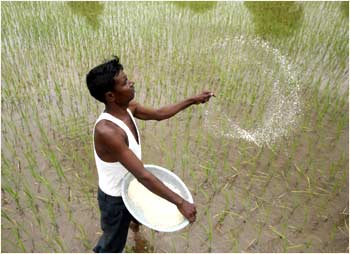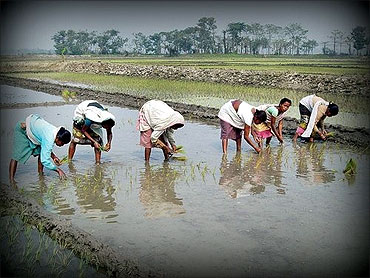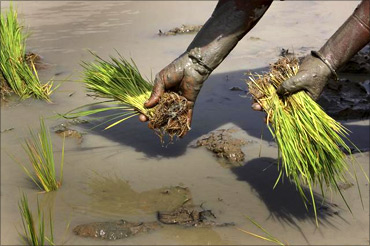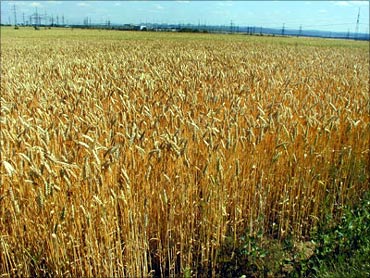 | « Back to article | Print this article |
Budget: Is there enough in it for farmers?
Finance Minister Pranab Mukherjee has committed to introducing a National Food Security Act in the current fiscal year, even while acknowledging the poor 'supply side response' of the agricultural sector in meeting increasing food demand.
He has -- predictably -- announced a slew of measures for improving agricultural production so as to curb food inflation.
But the most effective of these may well prove to be his invocation to Lord Indra for a 'bountiful and timely monsoon'!
He's increased the quantum of rural credit, with particular emphasis on short-term crop loans for small farmers and focussed heavily on improving food storage and processing infrastructure as well as supply chain management.
Click NEXT to read further. . .
Budget: Is there enough in it for farmers?
To meet the increasing demand-supply gap in pulses, vegetables, meat and poultry and oilseeds, he's announced Rs 300 crore (Rs 3 billion) each for their promotion.
A similar allocation has been made for coarse cereals, fodder and organic farming.
Enhanced flow of credit to farmers must be weighed against the sharp rise of input costs in agriculture over the last year, particularly (i) fertilisers (ii) labour (iii) power and (iv) seeds.
The impact of the nutrient-based fertiliser policy, introduced last year, is now being felt in terms of higher fertiliser prices.
At the same time, localised shortages of fertilisers like DAP because of hoarding and black-marketeering has led to unrest among farmers.
In this scenario, the proposed direct cash subsidy to farmers on account of fertilisers may not have the desired impact delivery. . .
Click NEXT to read further. . .
Budget: Is there enough in it for farmers?
Labour costs have also shot up, because of the introduction of the NREGS.
Further, with falling water tables, investment in submersible pumps, diesel and power have gone up, making it hard for farmers to meet bill payments.
Thus, increased credit in a time of spiralling input costs does nothing to liberate the farmers from the debt trap which continues to lead to tens of thousands of farmers suicides every year.
Further, the absence of a limit on borrowing rates for micro-finance is a big blind spot -- rates as high as 24 per cent are prevailing in some areas.
If micro-finance continues to thrive in these circumstances, there is a clear gap in institutional finance -- why should this be so if it is available at an effective rate of 4 per cent?!
Nor has the push for an 'income commission' for farmers been accepted.
The strategy for increasing foodgrain production will not win any kudos.
Click NEXT to read further. . .
Budget: Is there enough in it for farmers?
On the one hand, the finance minister regretted the adverse impact of Green Revolution technologies in terms of decline in soil health, overuse of chemical inputs and the increasing demand-supply gap in critical commodities.
On the other, he committed Rs 400 crore (Rs 4 billion) to boosting the 'East India Green Revolution'!
There are two reasons for this.
First, the government needs to reduce the over-dependence of the PDS on Punjab and Haryana, considering the critical water and power shortage, the loss of soil fertility and decline in agricultural productivity in these states.
Second, there is pressure from economists and experts to follow the 'China model' and boost per hectare productivity of foodgrains through the massive application of technological inputs.
Click NEXT to read further. . .
Budget: Is there enough in it for farmers?
The consequent acute water crisis in North China is not taken into account.
East India, with its fertile soils and abundant water, may well witness an increase in food productivity by the application of green revolution technologies but this will be short-lived and expensive in ecological terms.
While stress on improvement of food storage and processing and bridging the gap between farmers and markets the finance minister -- significantly -- stopped short of facilitating foreign direct investment in multi-brand retail.
This comes as a relief to food policy activists, who fear the vertical and horizontal integration of the food supply chain (US-style) will negatively impact farmers and consumers.
While massive amounts of public and private capital are going into improving storage
infrastructure, no reform of the highly centralised procurement and distribution system has been proposed.
Click NEXT to read further. . .
Budget: Is there enough in it for farmers?
Localised production, storage and distribution would have proved far more cost effective by cutting down on infrastructure and transportation costs.
In that sense, the creation of vegetable clusters near urban centres is a good move, but it must be kept in mind that water supply may be a major constraint.
In terms of increasing edible oils production, the focus has, oddly enough, been on palm oil rather than traditional oils like mustard, sesame and groundnut -- which are far more suited to the Indian climate and constitution.
It is heartening that more than lip service has been paid to sustainable agriculture, although the allocations have been very small.
The allocation for fodder and coarse cereals in particular, is worthy of accolades, but will need supporting policy initiatives to implement properly.






